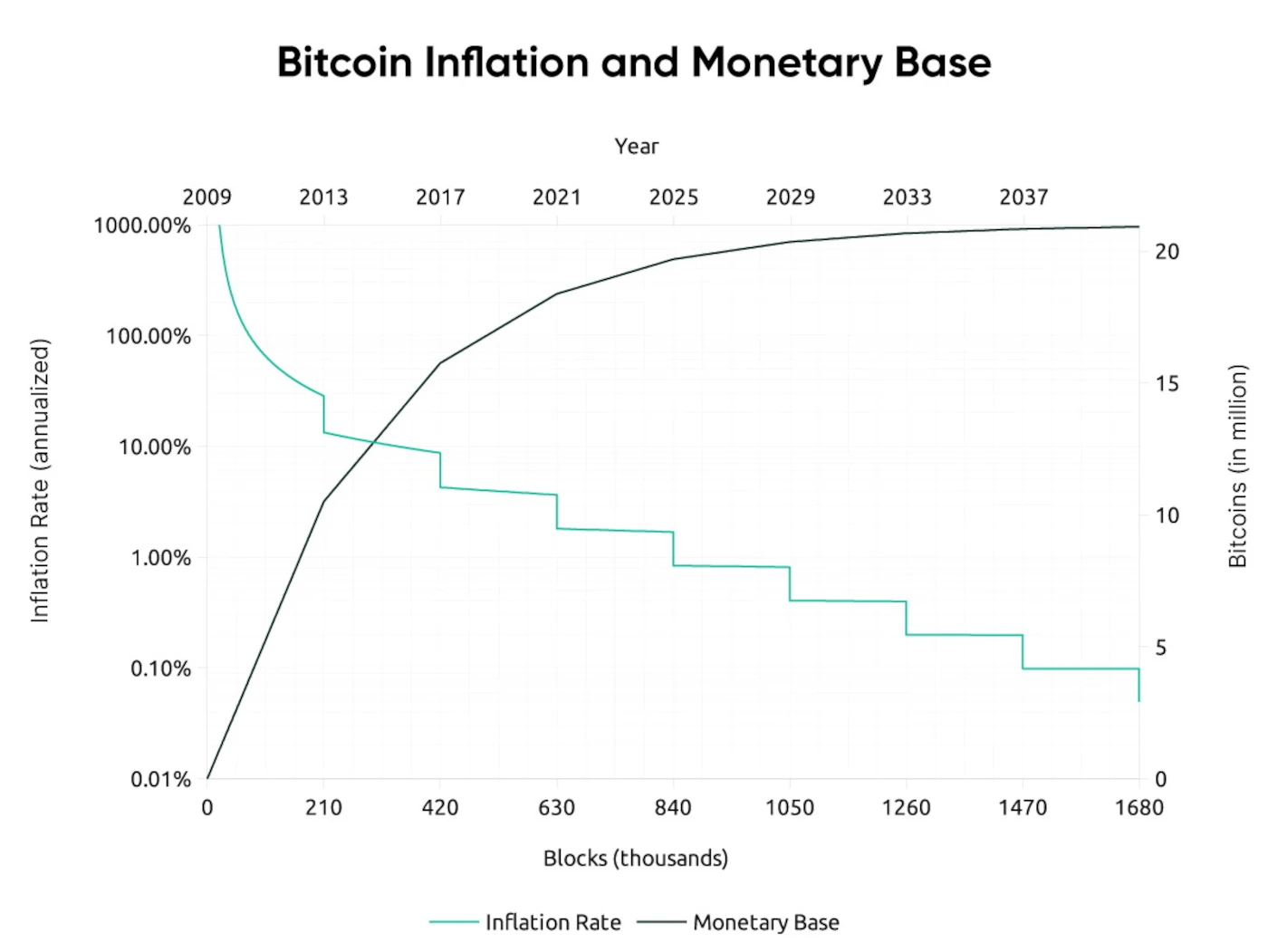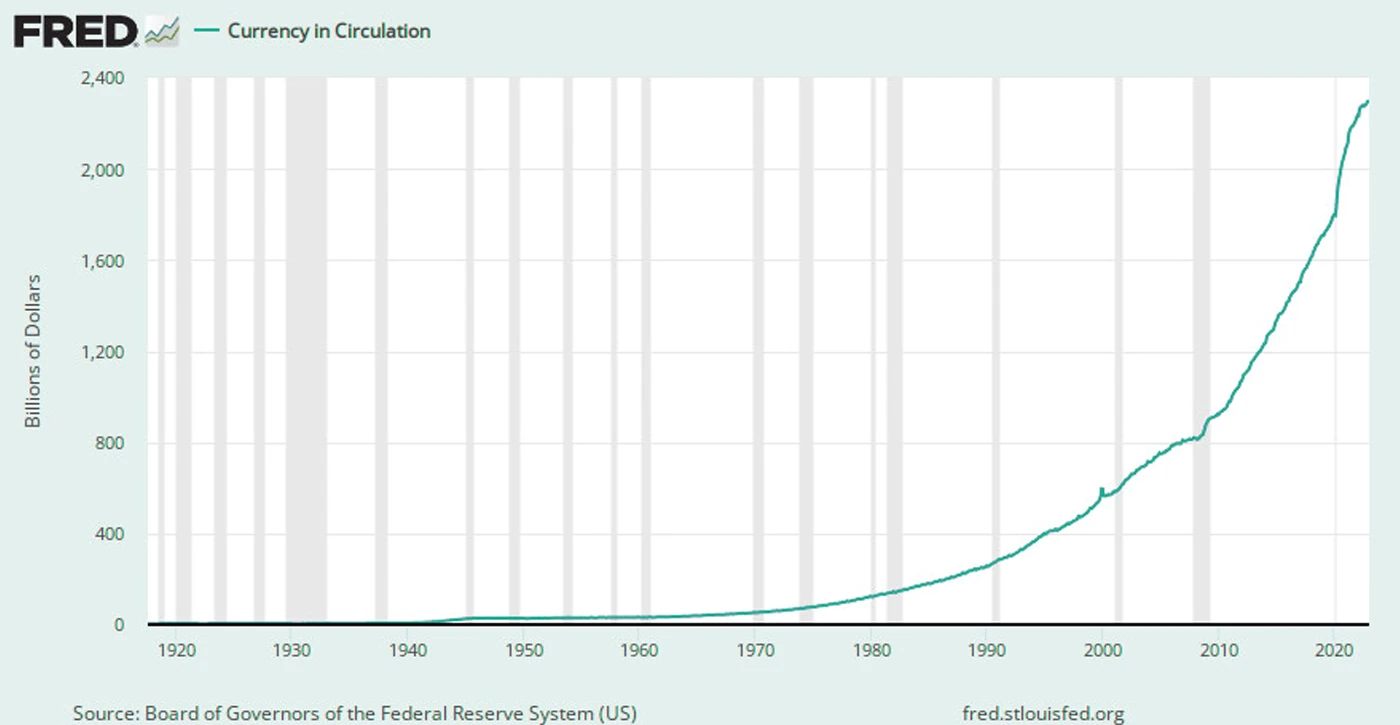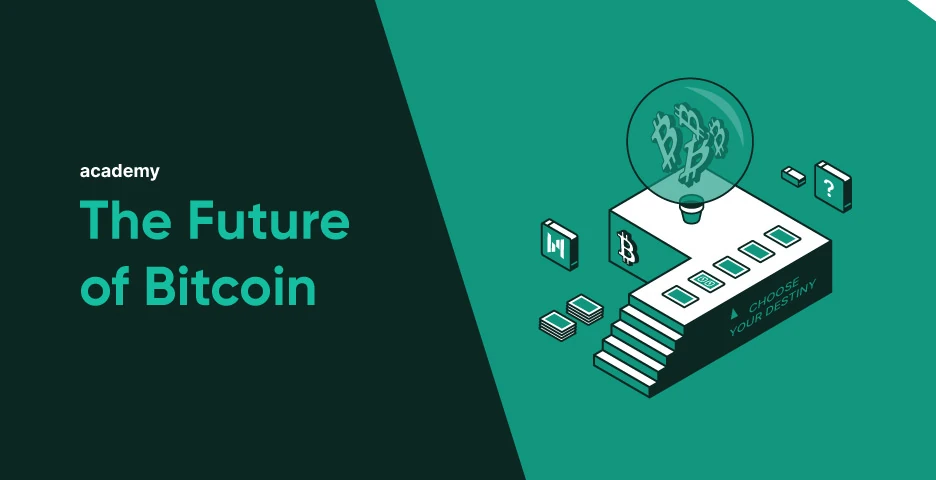An anonymous individual or group known as Satoshi Nakamoto created Bitcoin, the world’s first decentralized digital currency, in 2009. Since then, it has become one of the most popular and widely used cryptocurrencies globally, with millions of users and a market capitalization of over $470 billion as of February 2023.
Created as a sort of digital gold that was designed to be superior to existing forms of currency, Bitcoin has remained relevant and valuable despite critics repeatedly claiming it is worthless.
To some people it has already achieved its intended purpose, but to others it is still evolving as technology, regulation, and users respond to the dynamic digital finance landscape. Even though we can’t predict the future as it pertains to Bitcoin, we can examine past breakthroughs and make an educated guess on what we’d like to see happen.
Here are some likely scenarios we might see play out with the future of Bitcoin.
The Future of Bitcoin’s Hard Supply Ceiling
One of the defining characteristics of Bitcoin is its finite supply of 21 million coins. This hard supply ceiling is a key feature of the cryptocurrency and is designed to prevent inflation and ensure its scarcity.

One of the most common questions we receive from beginners is “what happens when the mining rewards are all gone”? The solution to this problem lies in the design of Bitcoin’s reward system, which provides incentives for miners to continue to secure the network has distributed all block rewards.
Once the community mines all 21 million Bitcoins, the block reward will drop to zero, and the network will switch to transaction fees as the primary source of miner revenue. These transaction fees will motivate miners to continue to validate transactions and secure the network.
This system is similar to how traditional payment networks operate and ensures that the network will continue to function even after all rewards are distributed.
The Future of Bitcoin as Currency
The first thought that comes to mind when someone hears about Bitcoin for the first time is that it’s a currency. They measure success by how many people use Bitcoin for purchases daily compared to other currencies, and the perceived trust large organizations and governments have when holding and exchanging Bitcoin.
Critics quickly jumped on the fact that Bitcoin’s processing power was relatively low. Fourteen years later critics point out that day-to-day use of Bitcoin is still relatively low compared to government backed fiat.
Bitcoin’s Adoption Curve
Despite our perception of how fast society adopts new technology, currency has always experienced a slow adoption rate. In stable markets, it takes generations to supersede another form of currency without a government mandate forcing people’s hand.
Even with government intervention, currency adoption can take years or decades to supplant barter and unofficial coinage. The United States gave itself the power to coin money in 1778, but didn’t start minting money in earnest until 1792, when Congress created the US dollar 14 years later. Pattern coins issued by independent coiners would still circulate well into the 1790s. To secure US currency, Congress adopted the gold standard, which increased trust.
The US dollar, as we know it today, wouldn’t be printed until 1914. After WWI, European countries sent gold to pay back US loans. Many started pegging their currencies to the US dollar after the war, which put the dollar in the position of prominence that we expect Bitcoin to rise to in just a few years.
The US dollar wouldn’t stand on its own until 1971, 179 years after its origin in 1778. Bitcoin, on the other hand, has had enough time to complete technical proof. The relative market cap and usage that is required to be considered a world leading currency would take decades, possibly a world war or two, and finally, legislation. Like the US dollar, competing interests will not cede authority easily. Expect major inflection points rather than time to affect Bitcoin’s adoption.

Bitcoin’s Promise as a Foundation for Micropayments
As for Bitcoin’s processing power, layer 2 solutions like the Lightning Network have already made significant advances.
The Lightning Network, a second-layer solution for Bitcoin, improves the scalability and speed of the network, making it more practical for everyday transactions.
VISA claims it can complete 65,000 transactions per second (TPS), and it was reported that VISA reached a peak TPS of 47,000 during the 2013 holiday season.
Bitcoin is capable of 7 TPS. The Lightning Network is capable of 1,000,000 TPS, and the founders believe it could be scaled even faster than other payment processors.
In this paradigm, users can choose from several technologies, all rooted in the Bitcoin blockchain, to make all sizes and types of transactions, all of which are faster than the traditional equivalents.
Bitcoin transactions are faster than bank wire or Western Union, and the Lightning Network is faster than VISA.
Facilitating Transition
During a hypothetical transition period from fiat to Bitcoin, many people will prefer to transact in one or the other. Mintlayer solves this point of contention with its own Lightning Network integration.
On Mintlayer, you can open Lightning Network channels that seamlessly integrate Bitcoin and Mintlayer tokens.
A node can set up a channel nominated in bitcoin, and a channel nominated in a stablecoin, making it possible to exchange currencies during a transaction. Small businesses will process sales cheaply in Bitcoin, but receive payment in a stablecoin on Mintlayer. This will be a valuable tool for the transition between a generation that grew up on fiat, and a generation that has embraced the full potential of Bitcoin as the world’s currency.
Institutional and Nation State Adoption
As Bitcoin becomes more widely accepted as a currency, it starts to become more viable as an option for use as as official currency of small governments and nation states.
The first government adoption of Bitcoin will likely be from small nations that wish to offer an alternative to other national currencies being used by their citizens.
El Salvador and the Central African Republic have both adopted Bitcoin as an official legal tender. El Salvador has enacted a Bitcoin law that requires merchants to accept Bitcoin as well.
Just like how shifting economic power during World War I catalyzed the adoption of the US Dollar, monetary crises and hyperinflation will likely be a major catalyst in the adoption of Bitcoin at a national level.
To become sponsored and adopted by larger countries, Bitcoin must stabilize in volatility and become subject to regulation by those countries. This may look like a complete adoption of Bitcoin like El Salvador, or a digital state currency issued on a Bitcoin layer 2 platforms like Mintlayer.
The complete solution for volatility is the growth of Bitcoin holdings and usage. Bitcoin’s market cap of $470 Billion USD seems huge, but for a global currency it’s not a contender. It’s only 1/50th of the current market cap of USD.
An easy way to monitor Bitcoin’s ascension is to compare the Bitcoin maximized market cap of world currencies. In this model, Bitcoin is ranked #27, right behind the Turkish lira. It’s a major accomplishment for Bitcoin to grow so quickly. The downside is that much of this is from speculation, and through on-ramps, Bitcoin is one step from being liquidated to another form of fiat. To compete on the world’s stage with USD and CNY, Bitcoin needs to be as resilient.
Considering that Bitcoin has only been around 14 years, its growth is unprecedented, but the world’s incredible expectations for Bitcoin and the powerful positions of fiat currencies like the US dollar make that growth seem understated.
The Future of DeFi Applications on Bitcoin
One facet of Bitcoin that is often overlooked by futurists is that it is first and foremost a technological breakthrough. Bitcoin’s development and surging popularity has inspired thousands of developers to create competing protocols and expanded ideas about cryptocurrency.
While many of these competitors offer nothing that Bitcoin doesn’t, some features, like the financial use cases found in decentralized finance, have allowed Ethereum to grow to a formidable size. Despite the incredible potential, Bitcoin has remained the cryptocurrency frontrunner. These preliminary attempts made compromises, some necessary, that created a lot of friction between Bitcoin liquidity and the end use.
Recent improvements to the Bitcoin protocol have opened up new opportunities for developers to explore decentralized finance on the Bitcoin blockchain. Bitcoin script allows for primitive smart contracts, and the Ordinals protocol created a cumbersome method for minting NFTs on individual sats.
Even more promising are layer 2 protocols like Mintlayer that run as a Bitcoin sidechain. Mintlayer combines the incredible potential of DeFi with the Bitcoin network by removing as much friction as possible.
Mintlayer is a sidechain that is highly compatible with Bitcoin, but features a technology stack that allows for building extensive DeFi uses and other financial applications like Ethereum. Mintlayer achieves the added functionality all Bitcoin maximalists want without clogging up the base layer with uses better suited for a layer 2 protocol.
Through Mintlayer, users can access their Bitcoin for financial use cases in just one step, without a wrapped token or bridge. This will bring many exciting projects to Bitcoin, such as:
- Smart contracts
- Payments with near instant built in currency exchange
- Decentralized exchanges
- Token generation
- Security tokens
- NFTs
- Marketplaces
- Derivatives
- Lending
- Mutual Funds
- Options
- Infrastructure projects
We are only beginning to scratch the surface of the full potential of having a high technology platform that is compatible with a leading reserve currency.
The Bitcoin Connected Home
The first time I heard the word smart home was when Bill Gates wrote about his own home built in 1996.
“First thing, as you come in, you’ll be presented with an electronic pin to clip to your clothes,” Gates wrote in The Road Ahead. “The electronic pin you wear will tell the house who and where you are, and the house will use this information to try to meet and even anticipate your needs.”
Today there are hundreds of electronics manufacturers that use bluetooth, Wi-Fi, near field communication, sensor arrays, cameras, software in the cloud, and many other technologies to make Bill gates ultra sophisticated home of the future an attainable reality for everyone.
Given Bitcoin’s trajectory, we can foresee a future where certain pieces of technology, payment networks, software, soda machines, and hundreds of other mundane objects all connect to technologies that ultimately settle on the Bitcoin base layer.
For instance, just like the gold paid to the US after WWI was attractive for people that thought about using US dollars, a digital item that is connected to an NFT recorded on Bitcoin is more attractive to a gamer than one that isn’t.
The PlayStation network may have their own Mintlayer Lightning Network nodes to accept payments quickly and cheaply through their online store. After paying for a new game through a payment dapp on Mintlayer, the player’s MLS-03 NFT that proves ownership airdrops to the player’s wallet, which is connected to their PlayStation. It unlocks the new game download and helps protect PlayStation from digital piracy.
The Future of Bitcoin Regulation
The one thing that is certain about the future of Bitcoin is that it will be a major subject of financial regulation. Since Bitcoin is decentralized and governments can’t tamper with it, they will aim a lot of the regulation at people.
Some countries have adopted more permissive attitudes towards cryptocurrencies, while others have cracked down on their use. Still, regulation isn’t comprehensive and often left open to interpretation. The ongoing regulatory uncertainty will likely continue until a new generation of lawmakers is elected to the legislature of a major financial player.
A decentralized network like Bitcoin throws a spanner in the works of large sophisticated countries that are charged with securing their financial systems. Without control of the security, it’s hard for them to accept responsibility.
The first major country that invests in Bitcoin may find the Bitcoin network at the center of a large DDoS attack or a worm style attack that targets Bitcoin miners in an attempt to secure a 51% attack (a crossover of Conficker and Stuxnet). When Bitcoin becomes tied to specific nations, it becomes a target of everything that nation is a target of. Attacks are bound to happen, and even though the target is already big ($470 Billion) the association of an enemy state puts Bitcoin in the realm of ‘priceless’.
Current Institutional Attitude Toward Cryptocurrency
If you look at publications from major financial institutions like the IMF or the Brookings Institute, you will see a lot of negativity surrounding Bitcoin. They will often use the term cryptocurrency to downplay Bitcoin’s market leading position.
At the same time, most prestigious educational institutions have started blockchain programs. If it doesn’t happen sooner, the students that were products of these classes will be in charge of financial regulation, and will be more likely to draft smart and comprehensive legislation.
It will take some truly elegant legislation to address the problem of regulating something that is as decentralized as Bitcoin, but widespread use will force the hands of most governments sooner or later. Just like the US dollar, the future of Bitcoin will play out over decades if not generations. Its growth will not be linear, but will instead see exponential growth tied to other major events.
Mintlayer’s Role in The Future of Bitcoin
Bitcoin carefully chose a UTXO model for accounting and made script turing incomplete to prevent computational loops. Bitcoin hasn’t made major improvements often since the early days. When the taproot upgrade went live in 2021, it had been four years since the last major Bitcoin update.
Mintlayer has taken the same approach, using simple concepts that mimic real world transactions and prioritize stability.
Adding DeFi and other extravagant features to Bitcoin’s core is not what the community has ever wanted. Mintlayer will build the platform that is needed to make DeFi on Bitcoin work, allowing Bitcoin to concentrate on its own stated use case. Just like the Lightning Network facilitated micropayments for Bitcoin users, Mintlayer will bring a functional DeFi platform that doesn’t compromise core concepts. We have designed Mintlayer to be as future-proof as possible, just like Bitcoin!


